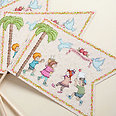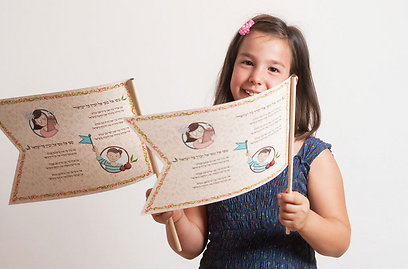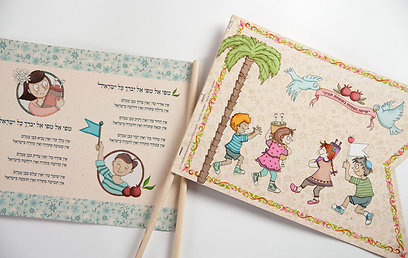
Simchat Torah flags go feminist
Jewish holiday's flags were always colorful and cheerful with drawings of dancing children, a Holy Ark, and sometimes even a small apple on top. The only thing missing was girls – but not anymore
Now it seems the next stage of this revolution has arrived: Egalitarian Simchat Torah flags – for boys and girls.
The people behind the new series of flags are graphic designer Dov Abramson and illustrator Elad Lifshitz, who managed to maintain the product's childish charm despite the innovation.

(Photo: Maoz Vaystooch)
"About a year ago I was approached by a friend of mine, who has a daughter and said she would love to see female characters on Simchat Torah flags," Abramson recounts how it all began.
"I liked the suggestion, and decided to try to design something suitable. As I am used to working with all religious sectors, without any exceptions, it was clear that I would try to create flags that, on the one hand, would fit as many religious groups as possible and not make them uncomfortable, and on the other hand, express the innovation in it all."
This perception led to the inclusion of the classic Simchat Torah liturgies and songs on the flags (like "Rejoice and be joyous on Simchat Torah"), alongside pictures of girls dancing alone with a Torah scroll or together with boys.

(Photo: Maoz Vaystooch)
According to Abramson, the drawings of the girls on their own are a type of positive discrimination: Throughout history boys have been shown alone, and now girls deserve the same place.
"We tried to present the widest variety possible of boys and girls, religious and secular," he says. "Although the illustrator was given a free hand, it appears that he was guided in some way, as the characters are of children rather than adults. I have no desire to shift this creation to arguments about the 'exclusion of women.'"

(Photo: Maoz Vaystooch)
Abramson stresses that in general, his studio refrains from creating "products" for sale. Most of the studio's work is artistic and deals with questions of identity, but this project was different due to the understanding that there is a certain public importance to these flags – and they were put up for sale.
"The truth is that I was surprised by the amount of orders, and the flags were sold very fast," he says. "We still have some more in stock, but they were bought by many liberal communities, and some conservative ones as well, which really saw the importance of sharing the holiday spirit with the girls. Naturally, many mothers bought the flags for their daughters."
The advertising campaign included pictures of girls waving the flags, in order to "stress the message that girls should be part of the celebration as well, because the Torah was also given to them," explains Abramson.
He concludes by stressing, "I am here to increase the love, not to start a dispute. That's why I wouldn't want the flags to be linked to arguments like the 'exclusion of women' and other controversial issues. That is not my intention. I just wish to emphasize the place women are entitled to through these flags."










